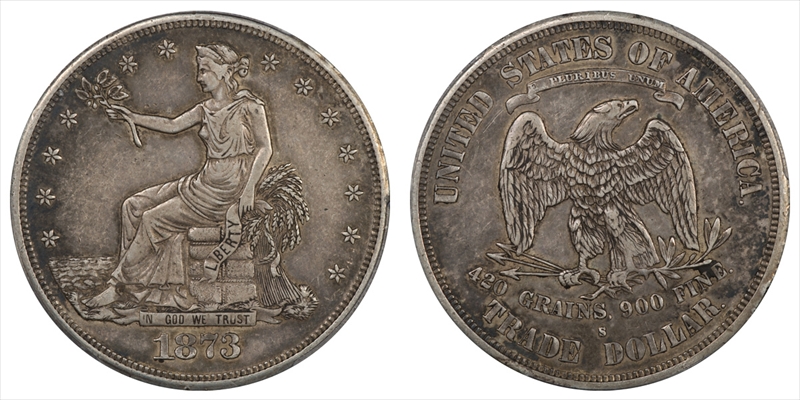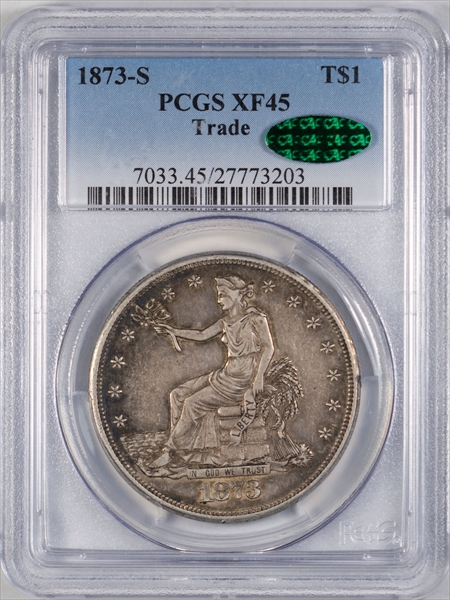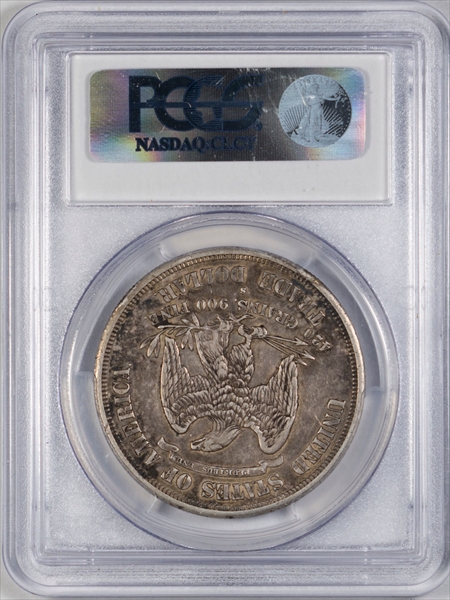1873-S T$1 Trade XF45 认证号27773203, PCGS号7033
拥有者评论
CAC approved. Original and choice.
专家评论
Q. David Bowers
The following narrative, with minor editing, is from my "Silver Dollars & Trade Dollars of the United States: A Complete Encyclopedia" (Wolfeboro, NH: Bowers and Merena Galleries, Inc., 1993).Coinage Context
San Francisco a prime mint for trade dollar coinage: From the beginning, emphasis was placed on producing coins at the San Francisco Mint. This was for two reasons. First, the San Francisco Mint was near the supply of silver (which primarily came from Nevada) and, second, it was the closest United States mint to the Orient. In Philadelphia in October, a powerful coining press for trade dollars was completed by Morgan & Orr and was subsequently sent to San Francisco (see reprinted article below).
Production in 1873: Production of trade dollars began in San Francisco in July and continued strong for the rest of the calendar year, with the peak month being December, when 200,000 were struck. Total coinage for the year amounted to 703,000 pieces. Nearly all were exported to China. The vast majority were melted there or in India.
Numismatic Information
Circulated grades: While hardly common, enough 1873-S trade dollars exist in circulated grades from VF-20 to AU-58 that there is no difficulty in locating them. I estimate that from 3,000 to 6,000 or more exist. Many were chopmarked.
Mint State grades: As virtually the entire mintage of 1873-S trade dollars was exported to China, and as numismatists in the United States (1) were not interested in collecting by mintmark varieties, and (2) were not interested in trade dollars, very few were saved domestically.
Today in all Mint State grades as a combined total population the 1873-S trade dollar is considered by me to be the rarest of all the regular San Francisco circulation strike issues 1873-1878. Even years ago, when population reports and other data were not available, the 1873-S was considered to be a prime rarity at this grade level. (For example, Maurice Rosen's article, "The U.S. Trade Dollar Series: An In-Depth Study," in the Gobrecht Journal, March 1980, named the 1873-S as the third rarest Mint State coin of this denomination.) However, if the grade MS-65 is considered separately, it is not as rare as 1874-S; I estimate that four to eight 1873-S dollars exist at this level, compared to zero or perhaps one of 1874-S. Some 1873-S trade dollars have vertical die striations on obverse and reverse and are partially prooflike.
In the sale catalogue for the John M. Willem Collection, sold on September 5, 1980, Henry Christensen described what was undoubtedly the finest 1873-S Willem had been able to locate: "Unc.-60, with a few light bagmarks. Very scarce without chopmarks."
Varieties:
OBVERSE TYPE I: RIBBON ENDS POINT LEFT, 1873-1876
REVERSE TYPE I: BERRY BELOW CLAW, 1873-1876
Circulation strikes:
1. Regular issue: Breen-5780. Fifteen pairs of dies were shipped, but to date specialists have not identified this number of minor variations. "Do any show broken serifs?" asks Walter H. Breen. Mintmark .9 mm high. "Minutes" as compared to certain mintmarks used in later years. One example seen by the author has microscopic vertical die striations (finishing lines) on the obverse and reverse and at casual glance appeared prooflike; light striking on eagle's dexter claws and on sinister leg and claws.
Many are seen as chopmarks.
Dies prepared: Obverse: 15; Reverse: 15. According to research by R.W. Julian, 6 pairs were sent from Philadelphia on July 13, 1873,6 more on September 22nd, and the remaining 3 pairs at an unknown date. Dies lasted longer than at Carson City. If all die pairs were used, over 46,000 coins were produced per pair.
Circulation strike mintage: 703,000. Delivery figures by month: July: 42,000; August: 111,000; September: 137,000; October: 98,000; November: 115,000; December: 200,000.
Characteristics of striking: Some have slight weakness on the eagle's sinister leg and on the eagle's claws.
Known hoards of Mint State coins: None
Rarity with original Chinese chopmark(s): Common.
Commentary
Coinage commenced in July 1873. Nearly all were shipped to China.
Additional Information
A New Coining Press
The American Journal of Numismatics, January 1874, pp. 62, 63, contained the following report:
"We were shown yesterday at the works of Messrs. Morgan & Orr, No. 1219 Callow hill Street, the new coining press, just built by them for the purpose of coining at the San Francisco Mint all denominations of silver and gold coinage, but especially the new silver trade dollar ordered by the Department of the Mint.
"This new machine weighs eighteen thousand pounds, and is made entirely of the best steel, iron, and brass produced in Philadelphia. The steel plate above the coinage stamp is home-made, and equal, if not superior, to the finest English, a fact that speaks well for our Philadelphia steel industry. The beautiful heavy brass beam was cast seven times over to secure its accuracy and exactness, as well as finish and strength. The large fly-wheel is cast hollow, and loaded with base metal so as to give it additional weight to counterbalance the heavy brass beam. This fly-wheel was cast in sections and securely united.
"In the front of the machine is a finely made brass cylinder to hold the unstamped coins, which, as the wheel revolves, slip down one at a time upon the sliding bed-plate of iron with apertures made to receive a single coin, then drawn into the machine, the stamp descends, andthe new trade dollar is carried out complete by an interior inclined plane. The heavy brass beam referred to of course controls the stamp. Perfect simplicity characterizes the machine, which is two and a half times beyond the capacity of any other coining machine that the firm ever made for the government. It is capable of striking eighty twenty-dollar gold pieces, equal to $1,600, per minute, or twenty [sic; it would seem that the number should be larger] silver trade dollars in a minute Philadelphia North American, October 16, 1873."
This same press is on exhibit today (in the 1990s) at the entryway of the American Numismatic Association Headquarters building at 818 North Cascade Avenue, Colorado Springs, Colorado.
PCGS #
7033
设计师
William Barber
边缘
Reeded
直径
38.10 毫米
重量
27.20 克
铸币数量
703000
金属成分
90% Silver, 10% Copper
更高评级数量
215
评级较低的钱币数量
29
地区
The United States of America
价格指南
PCGS 数量报告
拍卖 - PCGS 评级的
拍卖 - NGC 评级的
稀有性和存量估计 了解更多
| 所有评级 | 1000 |
| 60或以上 | 160 |
| 65或以上 | 5 |
| 所有评级 | R-5.0 |
| 60或以上 | R-7.4 |
| 65或以上 | R-9.7 |
| 所有评级 | 6 / 18 TIE |
| 60或以上 | 7 / 18 |
| 65或以上 | 10 / 18 TIE |
| 所有评级 | 6 / 18 TIE |
| 60或以上 | 7 / 18 |
| 65或以上 | 10 / 18 TIE |





























